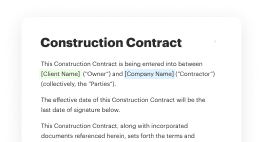Unlocking eSignature Licitness for Sales in European Union
- Quick to start
- Easy-to-use
- 24/7 support
Simplified document journeys for small teams and individuals




We spread the word about digital transformation
Why choose airSlate SignNow
-
Free 7-day trial. Choose the plan you need and try it risk-free.
-
Honest pricing for full-featured plans. airSlate SignNow offers subscription plans with no overages or hidden fees at renewal.
-
Enterprise-grade security. airSlate SignNow helps you comply with global security standards.







Your complete how-to guide - e signature licitness for sales in european union
eSignature Licitness for Sales in European Union
When it comes to eSignatures in the European Union, ensuring licitness is crucial. Understanding the legal framework surrounding electronic signatures is essential for businesses operating within the EU. This how-to guide will walk you through using airSlate SignNow to streamline your eSignature processes while complying with EU regulations.
Using airSlate SignNow for Easy eSignature Processing
- Launch the airSlate SignNow web page in your browser.
- Sign up for a free trial or log in.
- Upload a document you want to sign or send for signing.
- If you're going to reuse your document later, turn it into a template.
- Open your file and make edits: add fillable fields or insert information.
- Sign your document and add signature fields for the recipients.
- Click Continue to set up and send an eSignature invite.
airSlate SignNow empowers businesses to send and eSign documents with an easy-to-use, cost-effective solution. It offers great ROI with a rich feature set, is tailored for SMBs and Mid-Market, provides transparent pricing without hidden support fees or add-on costs, and offers superior 24/7 support for all paid plans.
Experience the benefits of airSlate SignNow today to revolutionize your eSignature workflows.
How it works
Rate your experience
What is the e signature licitness for sales in european union
The e signature licitness for sales in the European Union refers to the legal recognition and validity of electronic signatures in commercial transactions. Under the eIDAS Regulation, electronic signatures are categorized into three types: simple, advanced, and qualified. Each type offers varying levels of security and legal standing. Simple electronic signatures may include scanned signatures or typed names, while advanced and qualified signatures require specific identification methods and certification, ensuring a higher level of trust and security.
How to use the e signature licitness for sales in european union
To effectively use the e signature licitness for sales in the European Union, businesses should first determine the appropriate type of electronic signature required for their documents. This involves assessing the nature of the transaction and the level of security needed. Once identified, users can utilize airSlate SignNow to create, send, and manage their documents electronically. The platform allows users to fill out forms, request signatures, and securely store completed documents, ensuring compliance with EU regulations.
Steps to complete the e signature licitness for sales in european union
Completing the e signature licitness for sales in the European Union involves several key steps:
- Identify the document that requires an electronic signature.
- Choose the appropriate type of electronic signature based on the transaction's requirements.
- Use airSlate SignNow to upload the document and fill in any necessary fields.
- Send the document for signature to the required parties.
- Once all signatures are obtained, securely store the completed document for future reference.
Legal use of the e signature licitness for sales in european union
The legal use of e signatures in the European Union is governed by the eIDAS Regulation, which establishes the framework for electronic transactions. This regulation ensures that electronic signatures have the same legal standing as handwritten signatures, provided they meet specific criteria. Businesses must ensure that their electronic signature solutions comply with these regulations to maintain the integrity and enforceability of their contracts.
Key elements of the e signature licitness for sales in european union
Key elements of the e signature licitness for sales in the European Union include:
- Compliance with the eIDAS Regulation.
- Identification and authentication of signers.
- Integrity and non-repudiation of signed documents.
- Use of secure electronic signature solutions, such as airSlate SignNow, that meet legal standards.
Security & Compliance Guidelines
Ensuring security and compliance when using electronic signatures is crucial. Businesses should follow these guidelines:
- Utilize electronic signature platforms that comply with eIDAS and other relevant regulations.
- Implement strong authentication methods to verify the identity of signers.
- Maintain a secure environment for storing signed documents.
- Regularly review and update security practices to address emerging threats.
-
Best ROI. Our customers achieve an average 7x ROI within the first six months.
-
Scales with your use cases. From SMBs to mid-market, airSlate SignNow delivers results for businesses of all sizes.
-
Intuitive UI and API. Sign and send documents from your apps in minutes.
FAQs
-
What is e signature licitness for sales in European Union?
E signature licitness for sales in European Union refers to the legal validity of electronic signatures in business transactions across EU member states. It ensures that eSignatures are recognized as equivalent to handwritten signatures, providing security and compliance for businesses. Understanding this licitness is crucial for companies looking to streamline their sales processes.
-
How does airSlate SignNow ensure e signature licitness for sales in European Union?
airSlate SignNow complies with the eIDAS regulation, which governs electronic signatures in the European Union. This compliance guarantees that all eSignatures created through our platform are legally binding and recognized across EU countries. Our solution provides a secure and reliable way to manage documents while adhering to legal standards.
-
What features does airSlate SignNow offer for e signature licitness for sales in European Union?
airSlate SignNow offers a range of features that support e signature licitness for sales in European Union, including secure document storage, audit trails, and customizable workflows. These features ensure that every signed document is traceable and compliant with EU regulations. Additionally, our platform is user-friendly, making it easy for businesses to adopt.
-
Is airSlate SignNow cost-effective for businesses in the European Union?
Yes, airSlate SignNow provides a cost-effective solution for businesses in the European Union looking to implement e signature licitness for sales. Our pricing plans are designed to accommodate various business sizes and needs, ensuring that you get the best value for your investment. With our platform, you can save time and resources while maintaining compliance.
-
Can airSlate SignNow integrate with other tools for enhanced e signature licitness for sales in European Union?
Absolutely! airSlate SignNow offers seamless integrations with popular business tools such as CRM systems, document management software, and cloud storage services. These integrations enhance the e signature licitness for sales in European Union by streamlining workflows and ensuring that all documents are managed efficiently. This connectivity allows for a more cohesive business operation.
-
What are the benefits of using airSlate SignNow for e signature licitness for sales in European Union?
Using airSlate SignNow for e signature licitness for sales in European Union provides numerous benefits, including increased efficiency, reduced paper usage, and enhanced security. Our platform allows businesses to close deals faster while ensuring compliance with EU regulations. This not only improves customer satisfaction but also boosts overall productivity.
-
How secure is airSlate SignNow for e signature licitness for sales in European Union?
Security is a top priority for airSlate SignNow. Our platform employs advanced encryption and authentication measures to protect your documents and signatures. This commitment to security ensures that your e signature licitness for sales in European Union is maintained, giving you peace of mind when conducting business transactions.
Related searches to e signature licitness for sales in european union
Join over 28 million airSlate SignNow users
Get more for e signature licitness for sales in european union
- How to create a digital signature for a PDF on my ...
- How to apply an electronic signature on a document with ...
- Simplify your electronic sign in PDF process with ...
- How to create an e-signature for email documents ...
- How to add an electronic signature on a Mac and ...
- How to add a signature to a PDF file on my laptop ...




























